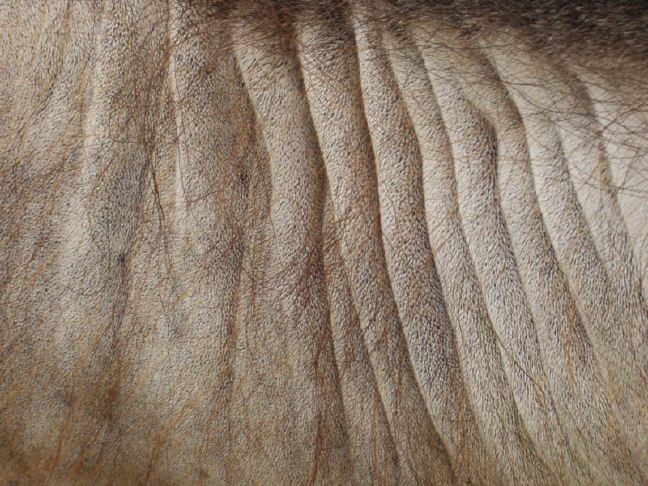|

A camel in the evening light.
Image Source: "Xikita"
/ License under Creative Commons
2.0
Available in two desktop sizes:
1024 x 768 || 800
x 600
Camel wool is a high quality fiber used in the Arab world for rug making and clothing.
[46] [47] Camels molt in the spring and a new coat is regrown by autumn. [48]
The average annual wool output per camel, is 7.23 lbs. (3.28 kg) for a male, and
4.63 lbs. (2.1 kg) for a female. The diameter of each fiber is about 12-27 microns
and the length ranges from 4-12 cm. Dromedary wool possesses several valuable properties
in today's markets, such as low heat conductivity, softness, and strength. Camel
wool may be manufactured into a wide range of warm fabrics. [49] A camel's fur may be shades of brown, nearly
white to almost black. [50]


Camel skin.
Image Source: Jan Krutisch
/ License under Creative
Commons 2.0
Available in two desktop sizes:
1024 x 768 || 800
x 600
Sexual activity occurs in both males (bulls) and females (cows) on a seasonal basis.
Increased daylight is believed to trigger the breeding urge. While sexual activity
in cows can commence at 2-3 years, a calf is not normally born until the cow is 5
years old. Ovulation is induced by mating. The cycle averages about 27 days. Depending
on the season, food availability, stress, etc., pregnancy length varies from 374
days (12.5 months) to 419 days (14 months). Each pregnancy will usually result in
a single calf being born, although twins have been known to occur. At birth, a calf's
eyes are open, and it already has a thick woolly coat. [51] A baby camel will weigh 66-88 lbs. (30-40
kg) and will not have a hump at birth. They will not start developing a hump, until
they begin eating solid food. [52] After only a few hours, a calf can run and
will call to its mother with a soft "baa," a little like a lamb. The mother
and the young camel will live together for several years, if not forcibly kept apart.
[53] In captivity, the calf is weaned at one year of age, and weighs about 331-397
lbs. (150-180 kg). [54] An average milking camel will produce 5.28-6.6 gal. (20-25 L) of milk a
day. A camel with well-formed udders may produce 8-10.6 gal. (30-40 L) a day. Camels
can give milk even under harsh conditions; and, unlike dairy cows, do not need much
or any supplements to do so. A camel can produce 5.28 gal. (20 L) of milk a day without
drinking any water for up to 10 days! [55] Camel milk is chemically similar to cattle
milk, but has a higher proportion of vitamin C. It also has more fat, protein, and
minerals than either cow's or goat's milk. [56] The period of production (lactation) is longer
than for cattle and the daily production lower. [57]


Baby camels.
Image Source: "Endlisnis"
/ License under Creative Commons
2.0
Available in two desktop sizes:
1024 x 768 || 800
x 600
While dairy herds are kept in parts of the Middle East, camel milk is said to be
an acquired taste. [58] The average cow gives birth every 2-3 years producing 8 calves by the age
of 20. [59] For domesticated camels, after they are weaned, the owner will start the
camel's education by teaching it to stand and kneel on command. He will also teach
the camel to carry a saddle or a light pack. The size of the pack will gradually
increase as the camel grows older. At 5 years of age, it can carry a full load. [60]
A camel is very closely related to a llama; and, in fact, the two were cross bred
in Dubai in 1997. The hybrid was called a Cama. [61] Sexual activity in bulls start at 3-4 years
of age. In the wild, a rutting bull will leave the bachelor herd and try to dominate
as many cows in his area as he can. An individual bull may continue his rut for 2-4
months depending on his health, nutritional status, and dominance. Severe weight
loss results in several dominant bulls being active throughout the breeding season
at different times. This is because rutting entails severe nutritional and physical
demands that exhausts each bull. [62]
|